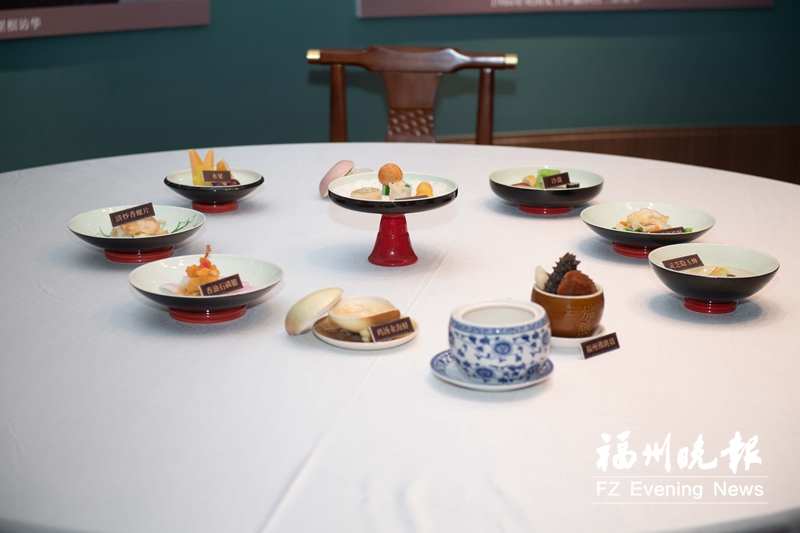Fujian Cuisine Culture Museum: A Collection of Delicacies

State Banquet Dishes(Photo/Lin Shuangwei)
Surrounded by mountains and seas, Fujian has a long coastline and therefore a rich supply of seafood all year round. The lush mountains boast numerous green bamboos, as well as tea, mushrooms, bamboo shoots and chestnuts with fragrance spreading afar. The unique natural resources of Fujian provide a sound and solid material foundation for the prosperity of Fujian cuisine. Let's have a good look at the delicacies at the Fujian Cuisine Culture Museum.
Asyou enter the hall, what comes into view are molds of various dishes, like bass, solen, abalone, etc.in the exhibition area of "Fujian Cuisine History." The guide told the reporter, "Since the topography and climate are different in coastal areas and mountainous areasinFujian, Fujian cuisine can be divided into 'mountain dishes' and 'seafood dishes.'""Mountain dishes"are prevalent in northern and western Fujian. The ingredients are mainly mountain products, poultry and livestock. "Seafood dishes"are common in eastern and southern Fujian. The ingredients are mainly seafood and river fresh.
On the second floor, in the exhibition area of “Authentic Fujian Cuisine”, a display wall shows delicate Fujian cuisine dish moldswhichwill make your mouth watery. Next to the display wall, there is abig electronic screen, creating an interactive experience. The “bubble” icons of 156 classic Fujian dishes, represented by Fuzhou dishes, are scrolled in turns on the big screen. With a click of any “bubble”, youcould view the ingredients and cooking techniquesof the corresponding dish.
The exhibition area of vegetarian dishes gathersthe molds of various dishes. In terms of cooking methods, the vegetarian dishes of Fujian cuisine can be divided into quasi-vegetarian dishes and full-vegetarian dishes. Quasi-vegetarian dishes arenamed after meat, cooked into meat patterns, flavored with meat, represented byvegetarian dishes of the Yongquan Temple in Mount Gu such asthe “Sauteed Sliced Abalone in Rice Wine Sauce”. Full-vegetarian dishes, withno meat in thename, are notcooked into meat patterns or flavored with meat, represented by vegetarian dishesof the South Putuo Temple in Xiamen.
Since ancient times, hosting a banquet has beena form of hospitality. In the development of Fujian cuisine, all banquets, from state banquets and Man-Han banquet to local fetes and traditional feasts, fully showdiverse localcustoms in Fujian.
Since the 1970s, Fujian cuisine has been selected into state banquets many times, becominga name card ofChinese catering culture. In 1984, the Fujian cuisine team consisting of master chefs Qiang Mugen and Qiang Ququ prepared a state banquet for U.S. President Ronald Reagan during his visit to China. The team worked out the menu within one day, which got approved without question and became the first menu “approved in one draft” in the state banquet history. The Scene Display Area shows the state banquet on that daywith a variety of dish molds, includingBraised Sea Clam with Chicken Soup, Fuzhou Juchunyuan’sFotiaoqiang, Deep-fried Bullfrog with Sesame Oil, etc.
Address: Area 6, Fuzhou Haixia Olympic Sports Center Commercial Plaza, Fuwan Road, Cangshan District, Fuzhou City. (Reporter: Quan Yiyue)